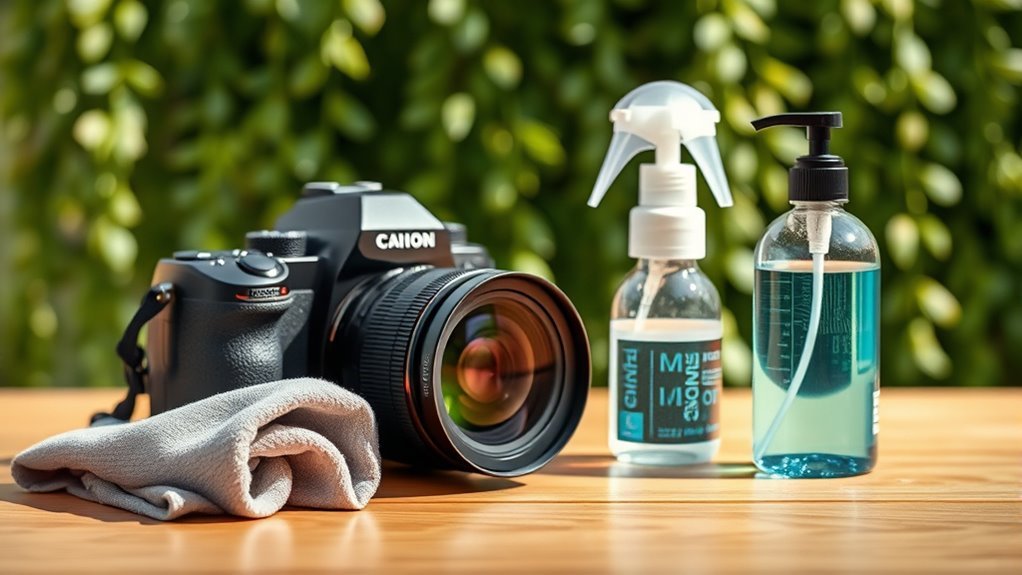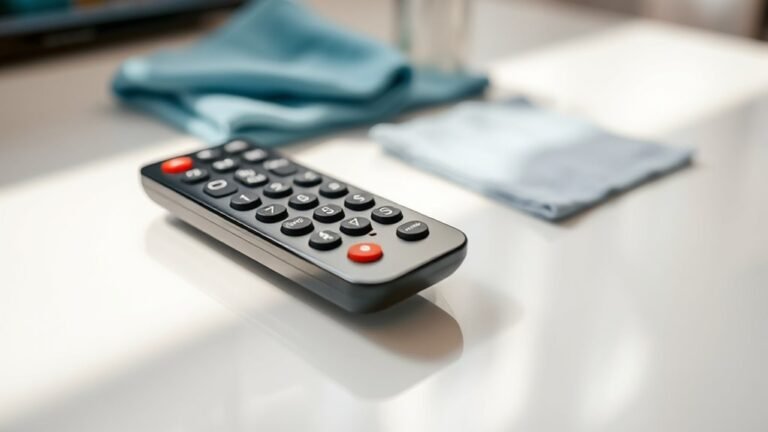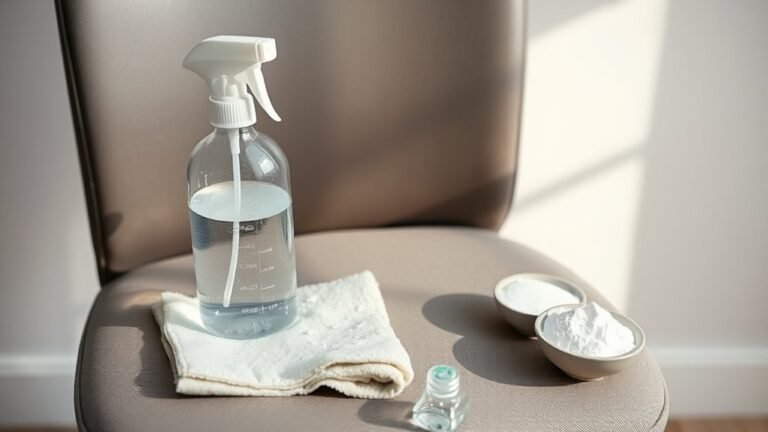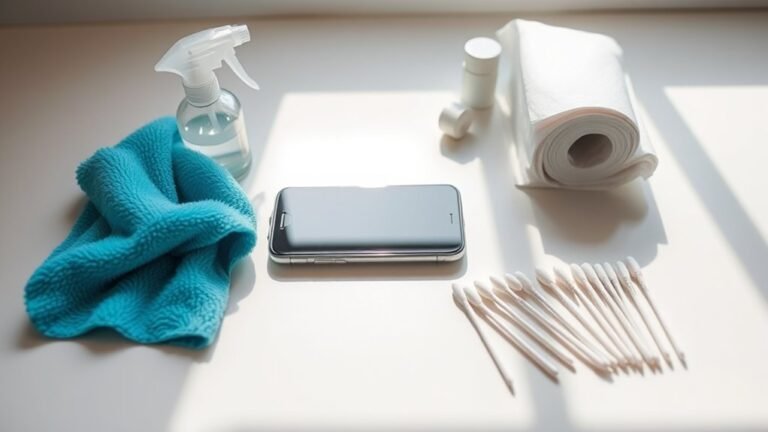Tips for Cleaning Photography Equipment Safely
To safely clean your photography equipment, start with gentle tools like a blower and microfiber cloths to remove dust without scratching. Use specialized cleaning solutions for lenses and sensors, avoiding household cleaners or rough materials. Handle controls with a soft brush, and check tripods for debris while keeping everything dry to prevent damage. Regularly cleaning and maintaining your gear protects your investment and guarantees great shots. Explore how to care for specific parts and keep your equipment in top shape.
Understanding the Importance of Proper Cleaning Techniques
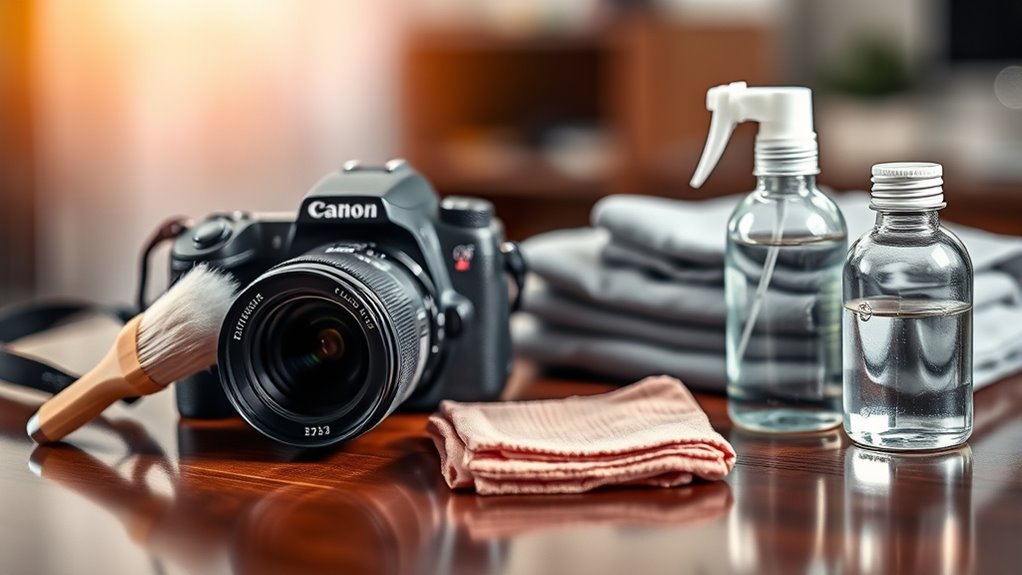
Although it might seem simple, using proper cleaning techniques for your photography equipment is essential to maintain its performance and longevity. You want your gear to keep up with your creative freedom, not hold you back. Understanding the cleaning importance means recognizing that careless handling can cause scratches, dust buildup, or even damage sensitive components. By adopting safe techniques, you’re protecting your investment and ensuring your camera and lenses deliver sharp, reliable results every time. Avoid harsh chemicals or abrasive materials, and always work gently to preserve delicate surfaces. When you respect your equipment with proper cleaning, you empower yourself to capture moments without interruption, keeping your creative flow unrestricted and your gear functioning at its best.
Essential Tools for Cleaning Camera Bodies and Lenses
To keep your camera bodies and lenses in top shape, you’ll need the right cleaning tools. Basic essentials include a blower, microfiber cloths, and specialized lens cleaning solution. Knowing which tools to use and how to use them will make maintenance quick and effective.
Cleaning Tools Overview
A few key tools can make cleaning your camera bodies and lenses much easier and safer. To maintain your gear effortlessly, start with a cleaning materials overview: a soft microfiber cloth, a blower brush, lens cleaning solution, and cotton swabs are essentials. These tools allow you to adopt effective cleaning methods without risking damage. The microfiber cloth gently removes dust and smudges, while the blower brush clears away loose debris from tight spaces. Lens cleaning solution, used sparingly, tackles stubborn spots without harming delicate coatings. Cotton swabs help you reach small crevices. Having these tools on hand lets you keep your equipment in top shape, giving you the freedom to focus on capturing the perfect shot without worry.
Lens Cleaning Essentials
When you want to keep your lenses spotless, having the right cleaning essentials makes all the difference. You’ll feel liberated knowing your gear’s protected and ready for every shot. Start with lens cleaning solutions designed to gently dissolve smudges without harming coatings. Pair them with soft microfiber cloths—they lift dirt effortlessly, sparing you scratches or streaks. Here’s a quick guide to your must-have tools:
| Tool | Why It Matters |
|---|---|
| Lens Cleaning Solution | Removes grime gently |
| Microfiber Cloths | Non-abrasive, streak-free wipe |
| Blower Brush | Clears dust without contact |
| Lens Pen | Precision cleaning in tight spots |
| Cotton Swabs | Detail cleaning around edges |
With these essentials, your camera stays free, ready to capture every moment clearly.
How to Safely Clean Camera Sensors
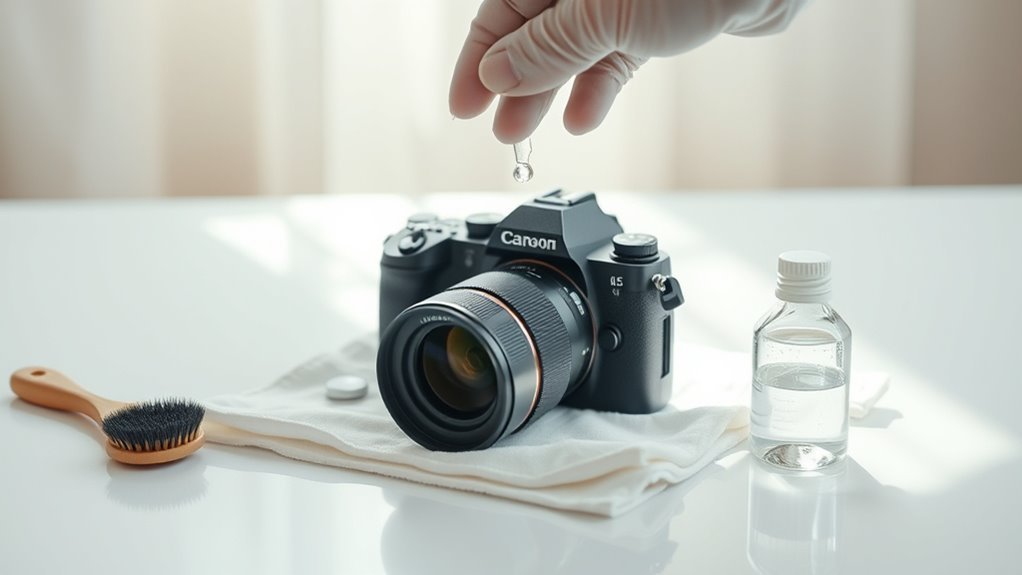
When it comes to cleaning your camera sensor, using the right tools is essential to avoid damage. You’ll need specialized sensor cleaning swabs and solutions designed for delicate surfaces. Let’s walk through a simple step-by-step process to keep your sensor spotless and safe.
Sensor Cleaning Tools
Although cleaning your camera sensor might seem intimidating, using the right tools can make the process straightforward and safe. To master sensor cleaning techniques, you’ll want a few essentials: a blower to remove loose dust, sensor swabs designed specifically for your sensor size, and sensor cleaning solution that’s gentle yet effective. Avoid household items—they can cause damage. Sensor maintenance tips always emphasize using tools made for delicate electronics, helping you maintain freedom from costly repairs. With these tools, you can confidently tackle dirt without risking scratches or residue. Remember, choosing quality sensor cleaning tools is key to keeping your gear in top shape and your creativity flowing without limits. Embrace these essentials for sensor care, and your camera will reward you with clear, sharp images.
Step-by-Step Cleaning Process
Before you start cleaning your camera sensor, make certain your workspace is well-lit and free of dust to avoid introducing new particles. Begin by removing the lens and activating the sensor cleaning mode on your camera to expose the sensor safely. Use a gentle blower to remove loose dust—never blow with your mouth. If spots remain, apply a few drops of specialized sensor cleaning solution to a sensor swab designed for your sensor size. Gently swipe the sensor once, then flip the swab and swipe again if needed. Avoid pressing hard to prevent damage. Always follow recommended cleaning techniques to maintain your equipment care routine. After cleaning, reattach your lens and test your camera to confirm no dust remains. Regular, careful sensor cleaning keeps your gear ready for freedom in photography.
Best Practices for Cleaning Camera Lenses and Filters
Since your camera lenses and filters play an essential role in capturing sharp, clear images, you’ll want to handle their cleaning with care. Start by blowing off dust using a gentle air blower—avoid canned air to protect delicate coatings. When smudges persist, apply lens cleaning techniques like using a microfiber cloth with a few drops of lens cleaning solution, wiping in a circular motion from center outward. For filters, regular filter maintenance tips include removing and cleaning them separately to avoid scratching your lens. Always store lenses and filters in protective cases when not in use. By mastering these simple steps, you’ll keep your gear ready for any adventure, ensuring your shots stay crisp without sacrificing the freedom to explore. Clean lenses mean freedom to shoot without limits!
Tips for Maintaining Your Camera’s Exterior and Controls
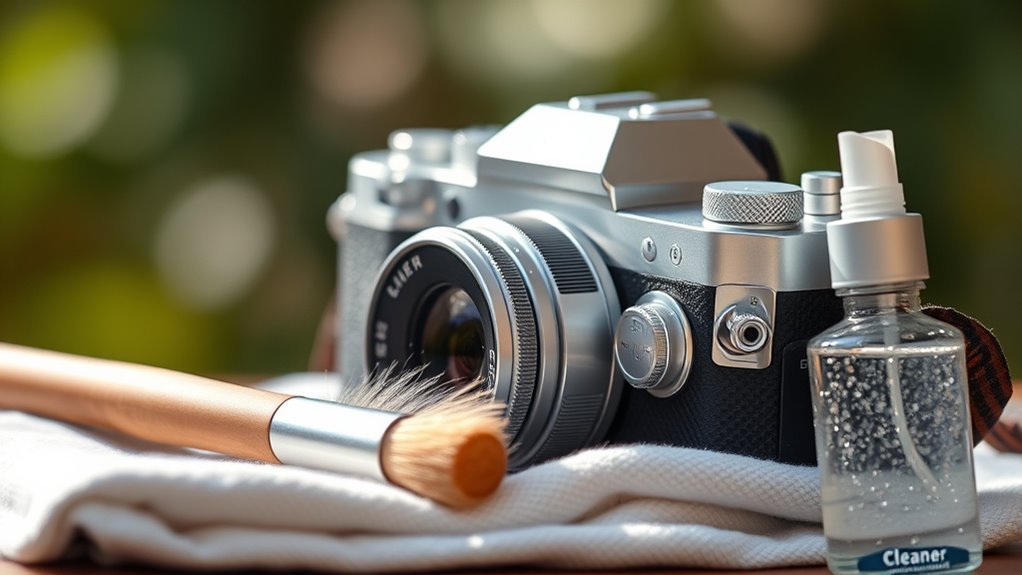
Keeping your lenses and filters spotless is just one part of caring for your camera. Exterior maintenance and control care guarantee your gear stays reliable and ready for every adventure. To keep your camera’s exterior and controls in top shape, try these tips:
- Use a soft, lint-free cloth to wipe the exterior gently.
- Avoid harsh chemicals; instead, use a mild soap solution for stubborn dirt.
- Clean buttons and dials with a small, soft brush to remove dust.
- Keep ports covered when not in use to prevent debris buildup.
- Regularly check for sticky or unresponsive controls and address issues promptly.
Cleaning and Caring for Camera Bags and Accessories
Three simple steps can help you extend the life of your camera bags and accessories. First, understand your camera bag materials—whether it’s nylon, leather, or canvas—and use appropriate cleaning methods like gentle wiping or spot cleaning to avoid damage. Next, focus on accessory organization; keeping cables, batteries, and memory cards neatly stored prevents wear and makes your gear easy to find when you’re ready to create. Finally, air out your bags regularly to avoid moisture buildup that can harm both the bag and its contents. By caring for your bags and accessories thoughtfully, you maintain your freedom to shoot anywhere without worrying about gear failure or lost items. Clean, organized gear means you’re always ready to capture the moment.
Frequency and Timing: When to Clean Your Photography Gear
Regularly cleaning your photography gear is essential to maintain its performance and longevity. Sticking to a cleaning schedule helps you avoid damage and keeps your equipment ready for action whenever inspiration strikes. Here are some practical frequency guidelines to help you decide when to clean your gear:
- After every outdoor shoot, especially in dusty or humid environments
- Monthly for lenses and camera bodies, even if unused
- Immediately if you notice smudges or dirt on lenses or sensors
- Quarterly for deeper cleaning of accessories like tripods and filters
- Before long-term storage to prevent buildup and corrosion
Frequently Asked Questions
Can I Use Household Cleaners on My Camera Equipment?
You shouldn’t use household cleaners on your camera equipment because they can damage sensitive surfaces and coatings. For proper camera maintenance, stick to products designed specifically for cameras, like lens cleaning solutions and microfiber cloths. Using the right tools helps you keep your gear in top shape without risking harm. This way, you’re free to focus on capturing amazing shots without worrying about ruining your equipment.
How Do I Prevent Mold Growth Inside My Camera Bag?
Think of your camera bag like a treasure chest on a damp pirate ship—mold is the sneaky enemy lurking in the shadows. To conquer mold growth, make certain your camera storage is dry and well-ventilated. Use silica gel packs to absorb moisture and avoid storing your gear in humid places. Regularly airing out your bag and keeping it clean will keep mold at bay, letting your equipment breathe freely and stay ready for your next adventure.
Are There Specific Cleaning Methods for Underwater Cameras?
When it comes to underwater maintenance, you’ll want to rinse your underwater camera with fresh water right after each dive to remove salt and debris. Use a soft cloth to gently clean the lens, ensuring lens protection without scratches. Avoid harsh chemicals, and let your camera dry completely before storing it. This way, you keep your gear free to capture all your aquatic adventures without worry or damage.
What Should I Do if My Camera Gets Wet During Cleaning?
Imagine your heart skipping a beat when your camera suddenly gets wet during cleaning—what now? First, don’t panic. Quickly remove the battery and memory card to prevent damage. Use gentle drying techniques like blotting with a microfiber cloth and letting it air dry in a cool, dry place. Avoid heat sources. You want to keep your gear safe and ready to capture freedom’s next adventure, so patience is your best friend here.
Can Compressed Air Damage My Camera Sensor or Lens?
You might worry that compressed air could harm your camera’s sensor or lens, but if you use it carefully, it’s generally safe. Just avoid blasting air directly onto the sensor to guarantee sensor protection. For lens maintenance, gentle bursts can remove dust without scratching. Remember, holding the can upright and keeping a good distance helps you keep your gear intact while enjoying the freedom to shoot without worries.
